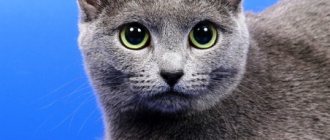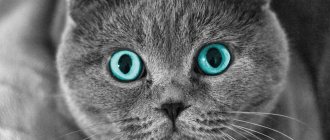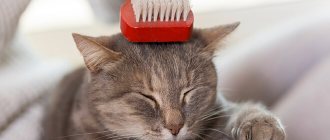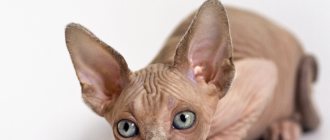One look from the blue slanting eyes of a Siamese cat can win the heart of any person forever. The unusual coat color, graceful body structure, active character and origin story shrouded in legends place this breed in a separate row among the many beautiful representatives of the cat family.
The Siamese cat breed appeared more than 6 centuries ago in the vicinity of Thailand. At the end of the 19th century, she came to Europe with the British ambassador, who received the Siamese cat as a high reward from the Thai king. Soon the Siamese breed began to take prizes at all European exhibitions.
Character traits
Beautiful strong muscles and bottomless blue eyes are a distinctive feature of the breed. The animal has an unusual coloring - cream, the tips of its paws are chocolate-colored, and on its face there is a dark mask and black ears. A peculiarity inherent in this variety is strabismus. Kittens are born white, but as they grow older, a unique coloring appears. Siamese kittens are short-haired pets.
If you decide to adopt this particular breed, you should carefully learn its temperament in order to be able to tame it. The Siamese cat is inquisitive, temperamental, loves to play, quickly adapts to a new home, rules and becomes attached to its owners. Gets along well with children. But you don’t need to get a small child, but you can get a kitten for a teenager. They require constant care and attention. They will meow until they get what they want. By nature, Siamese are similar to dogs; they are just as devoted to people, but they will be jealous of other animals.
If you offend a Siamese cat, he will remember for a long time and take revenge. Cats are especially dangerous and vindictive. They can attack a person at night when he is sleeping.
Conditions of detention
If all conditions are provided for a kitten, then it will grow up healthy. From childhood you need to strengthen your immune system and take care of your special ears, then an adult cat will not cause any problems in caring for it.
Initially, kittens are fed hypoallergenic food, and over time they are transferred to regular food.
All medications should be prescribed only by a veterinarian who knows what this species is allergic to and how to treat it correctly.
Like all breeds, these cats require not only a lot of attention, but also proper, timely care.
It is important to monitor the cat’s health; if it worsens, you need to see a doctor, since Siamese cats are prone to cancer, in order to start treating it in time, you need to seek help in a timely manner.
Preparing to maintain a home
It is necessary to create favorable conditions for the new family member. You need to take the baby away from the mother no earlier than 1 month after birth, but the later the better. Maintain the temperature at home at least 25 degrees, remove drafts, these animals love warmth. You need to buy a place where the kitten will rest. This could be a bed or a house, buy toys, because the Siamese cat is playful. Various shampoos for bathing, scissors for trimming nails, a comb for combing out fur, bowls for food and water, and a tray will come in handy. It is necessary to install at least one scratching post to protect the new wallpaper. You need to decide what to feed the animal. Remove small parts from accessible places and fence off wires.
Siamese cat: character traits and behavior
Once in a family, a Siamese cat or she-cat immediately chooses one owner. They single him out from all family members and are devoted to this choice all their lives.
They have an independent character, highly developed intuition, and love to explore and play. Smart, active, willful, demanding of communication. They do not tolerate unceremonious treatment. They do not forgive insults, they know how to stand up for themselves.
They quickly get used to a new environment. They express their needs and feelings in a voice whose intonations have many variations. If a cat is very scared or dissatisfied with something, it can express protest with a long and loud howl.
Very often they are jealous and do not want to share their owner’s love with other family members and animals. They are wary of outsiders. They tolerate sharp sounds and excessive noise very poorly. A dysfunctional atmosphere in the family can lead to illness in a Siamese cat.
Kitten care
How often can you bathe?
Siamese cats are clean, but the owner must help. Cat care includes cleaning ears, eyes, teeth, combing fur and bathing. It is necessary to regularly inspect the ears for the presence of wax accumulation. It is recommended to wash them at least once a week with special products that are sold in veterinary pharmacies. The corners of the eyes should be wiped with a damp cotton swab moistened with saline. solution or boiled water. There are special toothpastes for animals that are used to periodically clean their teeth. Grooming does not take much time due to the lack of undercoat. Only during shedding does it need to be brushed 2 times a week. It is recommended to bathe no more than 3 times a day. in year.
Feeding
Food should be balanced and contain essential vitamins and microelements. You can feed them natural food or dry food. The kitten's diet should contain sufficient quantities of meat - beef, chicken, offal (lungs, heart, liver). They should be given boiled. You can have fish, but not often and without bones. There should always be water or milk in the bowl if the kitten wants to drink. Feed 6 times a day, reducing the number of feedings with age. Give an adult animal food 2-3 times a day. You should not give chicken and fish bones, fatty, fried, spicy, salty, chocolate and other sweets in large quantities.
The advantage of dry food is that you don’t need to decide on your own what to give in what quantity, everything is already balanced there. There are as many vitamins and microelements as needed to keep the animal active, with a healthy and shiny coat. But there is no need to waste money and choose cheap food. The following are considered useful:
Nail care
It is necessary to educate and teach to trim claws from a very early age. The procedure is carried out as it grows. To do this, it is recommended to find a quiet place where the kitten will not be distracted. The animal needs to be placed in the arms, calmed, take the paw and press on the pad. A claw will come out. You need to trim a little bit each time, vertically, so as not to touch the blood vessel. If the cat begins to worry, stop trimming. For the procedure, special scissors are used - nail clippers. After everything is over, reward the baby with a treat. He must remember that after trimming his nails there will be something tasty.
Upbringing
A correct understanding of animal psychology makes it possible to raise a kitten well from a young age. It is necessary to accustom him to the tray from childhood. This breed is endowed with intelligence, so they easily remember commands, what are “dos” and “don’ts.” If a kitten behaves badly, you should not punish, much less beat. You need to wait until he calms down and starts doing the right thing, then praise him and give him a treat. Siamese are unpretentious in maintenance and amenable to training. You can even take them out for a walk on a leash, they will react normally to this and will not mind.
Vaccinations and antiparasitic treatment
Since Siamese cats are susceptible to viral and infectious diseases, they are regularly vaccinated against calcivirosis, rhinotracheitis and panleukopenia. The first vaccination is given to a kitten at the age of 7-8 weeks. After 4 weeks, the animal is vaccinated against the same diseases and against rabies. Subsequently, the Siamese cat is vaccinated once a year.
To protect the animal from diseases transmitted by fleas and worms, it is systematically subjected to antiparasitic treatment. Anthelmintic drugs are given to a Siamese cat once every six months with mandatory repetition after 10-14 days. To combat fleas, special drops, shampoos and collars are used.
Nutrition and care of Siamese cats
Siamese are picky eaters and fickle in their tastes.
Siamese often love to eat unexpected foods: nuts, corn, mushrooms, sweets, fruits. When feeding natural foods, ensure variety and remember that a meat diet causes darkening of the coat in Siamese cats. It will be better if at least 30% of the diet comes from fish. When feeding with ready-made food, feed only food from well-known manufacturers of premium, superpremium or medium class - “Yams”, “Hills”, “Boi” and others. Make sure your cat always has access to water. Siamese drink a lot, preferring running or settled fresh water. They are picky about their water container. Some prefer the owner's bowl, others require water to be poured into a bucket (for some reason, many Siamese suffer from gigantism disease), others drink only water flowing from the tap. Always make sure that the water is not cold, as Siamese are prone to colds.
Feeding
A properly formulated feeding diet is very important for your pet’s health. Some owners prefer ready-made dry food. After all, it contains the entire necessary set of vitamins and minerals. Others believe that the natural type of feeding is correct and will help the animal remain healthy and beautiful and will extend the years of its life.
If you belong to the second type and are a supporter of natural nutrition, you need to create a menu correctly. The main product is meat. This can be lean beef, rabbit and chicken. Before feeding, the meat must be boiled, frozen for several days, or doused with boiling water. Meat should not be given to the animal in large pieces, but finely chopped and warmed up a little just before feeding.
Your pet's diet can be varied with a small amount of cereal, egg yolk, butter, and various vegetables. If the pet does not refuse, you can occasionally treat it with fruit.
Fermented milk products are a real treat for the Siamese cat.
Under no circumstances should you give your animal food from the table, such as smoked meats, sweets, bakery and sausage products, and river fish. Fruits and vegetables such as grapes, peas and beets should be avoided because they cause fermentation in the animal's body. Under no circumstances should you give your animal carbonated or alcoholic drinks.
You should not experiment and treat your pets to citrus fruits; very often they cause allergies.
When feeding naturally, do not forget about vitamins. The veterinarian will definitely tell you which complex should be given at what time.
Appearance of a Siamese kitten
The head is narrow, with a long, narrow muzzle, a massive chin, and a straight nose. The skull is distinguished by its flatness. The eyes are bright blue (a green tint is considered a deviation from the standards), almond-shaped and slightly convex, small in size. They are positioned somewhat obliquely towards the nose. Large triangular ears spread to the sides. The body is elongated and proportionate, the belly is tucked, ending in long slender legs, the front ones being slightly shorter than the long ones. The tail, thin and long, is pointed at the tip. Weight is small, 3-4 kg.
Appearance
- Elongated body, long legs, oval-shaped paws.
- The head is oval.
- The muzzle is thin, the nose and chin are at the same level.
- The ears are wide downwards.
- The eyes are almond-shaped, slightly sunken, the color is bright blue, this is a distinctive feature; no other breed has such a beautiful and rich color.
- The tail is elongated and thin.
Head
The head is wedge-shaped, and the shape of the skull is flat and very easily visible through the skin, the muzzle is thin, the nose is elongated, and only some representatives have cheeks.
Weight
Average weight - from 4 to 5 kg, depending on the accessory.
Frame
The skeleton looks fragile and small, but this is deceiving, since the pet has well-developed muscles, all the animal’s movements are light, fast and clear.
How are Siamese kittens born?
You will be surprised, but they are white. Only the nose and pads have a pink tint. Then the fur darkens. This happens at 2 weeks of age. The lower the room temperature, the darker the shade of the cover. Siamese kittens, born and constantly living outdoors, are almost brown at the first molt, the color of the stripes is black. And mustaches that live in warm conditions are cream or creamy beige in color with chocolate markings. The coat is not long, there will be no problems with its care and cleaning - 15 minutes of combing a day will be quite enough. Independent Siamese are characterized by pronounced hunter instincts and by no means a diplomatic oriental temperament.
Sometimes they show stubbornness and jealousy. At the same time, they become strongly attached to their owner and love children. And they are wary of strangers and other pets. Siamese kittens have excellent intelligence, are highly intelligent, are able to capture not only the tone, but also the shade of speech, they do not like to be criticized and are offended for a long time. Regarding the peculiarities, they note that long fingers allow pets of this breed to skillfully use them for “criminal purposes,” for example, opening doors and cabinets, unzipping a bag or similar locks.
Preparing a place for a kitten
Keeping a Siamese cat in even a spacious city apartment is quite a serious task, so it is very important for the future owner to properly prepare for the moment the kitten appears in the house. Raising a Siamese kitten is in many ways much more difficult than keeping an adult pet .
Small creatures are quite whimsical to all environmental conditions, and any carelessness can cause illness or death of the animal, so it is advisable to adhere to the following recommendations:
- the kitten must be transported in a special, completely injury-proof carrier;
- all objects dangerous to the kitten in the room allocated for keeping the animal must be removed;
- electrical wiring in the room is protected with special boxes or treated with citrus oil, the smell of which will scare away the animal;
- desk and cabinet drawers must be securely fixed or closed;
- it is necessary to block all narrow spaces between the walls in the room and pieces of furniture;
- indoor poisonous plants should be placed in areas inaccessible to your pet;
- bowls for food and water should be located at the maximum distance from the litter tray.
Particular attention is required to preparing a place for the Siamese kitten to sleep and rest. Such an area should be fully protected from drafts, and using a warm heating pad wrapped in a towel will help the kitten adapt as quickly as possible and fall asleep easily.
Return to content
Choosing between a girl and a boy pet
... many give preference to the latter, considering it more beautiful and less troublesome. Perhaps this is more correct, cats are very independent, creating an image for themselves as the owner of the house. The owners are considered servants; their character is curious, active, and at times irritable and aggressive. Cats are much calmer and more affectionate, more loyal and clean. However, there are always exceptions to the rules.
While their owners are away from home, smart cats will happily play with puzzle toys or spend time in a playhouse or a vertical sports complex. A nail sharpener is on the shopping list for pets so they don't scratch their claws on anything. Another pet companion, not necessarily a cat, can also help relieve boredom.
Education and physical activity
Siamese cats are smart animals with developed intelligence and good memory. They quickly get used to the tray and are quite easy to train. True, due to their character traits, representatives of the breed will demonstrate their skills only when they want.
Siamese cats have an active temperament. They need to create conditions so that they can splash out energy. To do this, Siamese are given several different types of toys and a tree house, which can be replaced with a corner with multi-level shelves and ladders.
How to name?
If you cannot decide what to name a Siamese kitten, then we bring to your attention the following names for a boy: Athos, Venya, Perchik, Nelson, Everet, Gordon, Pearl, Onyx, Mathias. Suitable nicknames for the girl are: Buffy, Toffee, Stephie, Shoko, Christel, Melanie, Walesi, Sukki.
The origin of the Siamese cat breed is surrounded by many legends, going back almost to the time of Noah’s flood. According to one hypothesis, a male monkey and a lioness on the Old Testament ark fell in love with each other, and as a result of this, a representative of the Siamese breed appeared.
A more realistic version calls the birthplace of Siamese kittens Thailand, previously Siam. Cats, considered guides to the other world, enjoyed special respect and were kept exclusively in royal families or monasteries. The export of kittens from the territory of the state was strictly prohibited. The kittens were brought to Europe to Queen Victoria at the end of the 19th century. She liked them so much that, thanks to her personal sympathy, the popularity of the Siamese increased greatly. centuries, cats came to Europe.
Interesting Facts
During the history of the existence of the Siamese breed, many interesting things have been associated with cats:
- There were many famous people among the lovers of these animals. Siamese have lived with Gary Oldman, John Lennon, Harold Wilson, Vivien Leigh, Anthony Burgess, Syd Barrett and Jimmy Carter.
- In 2003, a representative of the breed named Katie claimed the right to be called the fattest cat in the world. Her body weight was 23 kg.
- In the middle of the 20th century, at the Dutch embassy in Moscow, 2 Siamese dogs sensed something was wrong and began to scratch the walls, hiss and arch their backs. The employees of the institution quickly responded to this behavior of the animals and examined the premises - they found numerous hidden listening devices in it.
- There are several varieties of Siamese cats. They all look alike and belong to the Eastern Oriental group. The closest relative of the Siamese is the Thai cat. They have many similarities and are often confused with each other. And long-haired cats that appeared as a result of a natural mutation are called Balinese and have the status of a separate breed.
Caring for a Siamese kitten
It is simple due to the short hair and the love of cleanliness of animals of this breed; in addition to combing, take care of the eyes and ears by wiping them daily with a cotton pad soaked in Vaseline oil (for ear care) or in water (for the eyes).
Teeth are a pet’s weak point; weekly care in the form of brushing teeth and treating them with a special treat will make it easier.
The love of drinking (as opposed to swimming and water procedures) is in the blood of Siamese representatives; use a bowl with a wide bottom or a special automatic fountain drinker. Leave the food only in the amount that will be enough for one meal, wash the empty bowl with hot water before the next filling, and discuss regular food with your veterinarian. The tray also needs to be cleaned after the “hike”.
Siamese kittens are very popular and therefore widespread. If you are interested in the price, then Avito offers to buy kittens almost for nothing or free of charge “in good hands.” It is better to purchase a kitten with a pedigree from a nursery. Here their cost (based on data from Moscow nurseries) is from 15 to 25 thousand rubles, in the regions it is cheaper - 7-15 thousand.
Health, what can you get sick from?
You should buy an animal from a nursery, since they are raised there according to all standards and they monitor not only timely vaccinations, but also their appearance. One of the main indicators of health is the pet’s activity.
The average lifespan of a pet is 15-20 years, but there have been cases where they lived much longer.
This particular breed is considered hardy, so it rarely gets sick, but if the cat is stressed or not properly cared for, it can get sick.
Diseases.
- Baldness.
- Respiratory.
- Cardiomyopathy.
- Diseases of the respiratory system.
- Problems with coordination
Reviews
Reviews about pets are very different, but even negative ones cannot consider Siamese angry, vindictive or excessively aggressive. Experts believe that earlier, when kinks or bends in the tail were considered a point of the breed, the nerve endings were simultaneously pinched and the vertebrae were bent. The kitty felt constant pain and discomfort, so she was not inclined to tenderness or affection.
Owners described their Siamese kittens as “incredibly smart,” “the most affectionate creatures,” using the “toilet like a human,” able to accept training techniques, and playful and active friends with “the mother-in-law and the German shepherd.” Among the disadvantages, they noted loudness and excessive purring, jealousy, the requirement of absolute hygiene, vindictiveness, touchiness, and willfulness. Get such a pet and form your opinion about its character and personality.
Health and illness
Genetic breed abnormalities
The Siamese cat has congenital pathologies that are unique to this breed:
- Congenital strabismus. Visual impairment due to pathology of the development of the eyeball. Develops in cats with the acromelanism gene (Siamese, Thai). The gene affects the ability to see the world in a stereoscopic dimension. Because of this feature, Siamese see everything in a flat image.
- Broken tail. A crease in the tail is a sign of a breed defect. Curvature of the vertebrae leads to permanent pinching of nerve endings. Cats with this defect constantly experience pain and discomfort and can be aggressive because of this.
Other health problems
The unique wedge-shaped shape of the head and jaws means that cats of this breed swallow food without chewing. Because of this, plaque and tartar form and periodontal disease develops.
It is important to regularly care for the oral cavity and teeth, choose food of such a shape and size that the cat is forced to chew it
The lack of undercoat and the wedge-shaped narrow head of the cat make the animal vulnerable to various respiratory diseases
It is important to prevent your pet from becoming hypothermic, not to allow him to drink cold water, or to be in a draft.
Siamese cats often have:
- Amyloidosis. A pathology in which protein is deposited in the liver and kidneys of an animal. Causes chronic renal and liver failure.
- Glaucoma. Occurs due to increased eye pressure. May lead to retinal atrophy and blindness.
- Bronchial asthma.
- Hyperthyroidism. Pathology of the thyroid gland. Possible increased appetite, thirst, weight loss.
- Aortic stenosis. Congenital heart pathology, characterized by narrowing of the aortic opening. With this pathology, blood circulation is impaired.
- Dilated cardiomyopathy (enlargement of the heart). Genetic pathology leading to heart failure.
Prevention methods
To avoid these health problems, you need to take a responsible approach to choosing a kitten, ask the breeders for its documents and the documents of its parents, as well as the results of genetic tests.
The mandatory list of treatment and preventive measures should include:
- vaccination according to schedule;
- antiparasitic treatment;
- anthelmintic measures;
- vitaminization.
If a cat is not purchased for breeding, in the first year of life it is necessary to decide on its sterilization (castration).
Annually, treatment and preventive measures may require from 3,000 to 5,000 rubles.
Briefly about the breed
The breed standard was adopted after World War II.
According to him, the Siamese cat breed has the following characteristics:
- small size;
- the body is long, thin, graceful;
- the head is small, wedge-shaped, the muzzle is graceful, with a clear profile;
- legs long, thin, high-set, hind legs longer;
- the ears are set wide apart, wide at the base, sharp at the ends;
- eyes slightly slanted, exclusively blue;
- the tail is long, smooth, with a sharp tip;
- the coat is short, soft, lying close to the body;
- characteristic color (point).
The historical (royal) color is considered the main color. It is characterized by a light, often cream or beige, color with dark brown markings on the face, ears, paws and tail. But at exhibitions it is no longer uncommon to see cats of black, blue, silver, and lilac colors. Instances of complex, multi-colored colors appeared. Although many felinological organizations do not recognize colors other than truly royal ones.
Dark markings are associated with the anatomy of the breed. The pigment level of Siamese directly depends on the temperature of the body area and even the habitat. The colder the area of the body, the more pigment in the hair and the darker it is. Therefore, the paws, ears, muzzle and tail of the Siamese cat are darker. Although Siamese kittens are born an even light shade, the markings appear by 10 months. Moreover, if you keep your cat warm, its coat will become lighter in adulthood.
Strabismus and tail creases, previously considered the main characteristics of the breed, are now classified as defects.
A Siamese cat with such defects is not allowed for breeding or for exhibitions.
For full development, the Siamese cat needs movement and games. Radio-controlled toys are very suitable - they will help realize hunting instincts. Cats can play for hours, and it is a mesmerizingly beautiful sight. Most of those who have a Siamese cat post dozens of photos of their pets’ games on their pages, and each photo emphasizes the inimitable plasticity of the Siamese.
The short coat and thick undercoat are easy to care for; just brush them once a week with a brush. Wash your cat no more than 2 times a year.
Particular attention to the eyes and ears. They need to be cleared of secretions, and the ears are instilled for prevention. If the discharge is excessive, contact your veterinarian immediately.
Siamese are prone to dental problems, so make sure you buy cat toothpaste, cotton pads, bone brushes, and special toys.
Claws should also be treated. To do this, it is enough to cut them by 2 mm once every 2 weeks, and buy a scratching post.
Diseases, breed defects
The main symptoms of pet diseases, which will require immediate response from the owner of a Siamese cat, are presented:
- coughing and sneezing;
- diarrhea and vomiting;
- increased temperature;
- rapid breathing or tachycardia;
- presence of blood in excrement;
- significant loss of body weight;
- rapid weight gain and obesity;
- loss of appetite;
- copious discharge from the ears, eyes and nose;
- constant strong thirst;
- incontinence of bowel movements or urine;
- wheezing in the chest area.
A significant part of serious diseases can be prevented only through competent preventive procedures and systematic vaccination:
- rhinotracheitis of viral origin, calcivirosis and panleukopenia - at two months, followed by revaccination a month later;
- chlamydia – at 2.5 months with revaccination a month later;
- rabies - at three to four months.
Diseases common to Siamese include strabismus, pathologies of the respiratory system, as well as hereditary mental disorders and problems associated with the vestibular system. That is why it is advisable to choose a kitten with the help of a competent specialist.
Among other things, a good breeder will honestly point out all the breed defects of the pet . Defects include white spots and malocclusion, as well as eye colors other than blue or blue. Also considered defects are a kink or hooked tail, emaciated appearance, and significant deviations from established standards.
Return to content
Smart girl with character
Even the most notorious skeptics recognize the intelligence of the Siamese cat. Moreover, some of their habits are similar to those of dogs: they love to carry balls in their teeth, they can fetch slippers, they calmly walk on a harness with a leash, they follow the command “Sit!” The cat will do all this if the owner treats her attentively and fairly. It is not recommended to offend these cats; their intelligence and enviable memory will help them take revenge. So punishment should only be for really bad behavior.
But the Siamese cat is an excellent conversationalist. She does not squint while talking, her blue piercing eyes do not let go of your gaze.
A cat with such intelligence is capable of blackmail. She will quickly learn that her shrillest voice among cats will always help you get what you want. And he will scream annoyingly until he gets his way.
But if harmony is achieved in the relationship with the owner, the Siamese cat pays with strong affection. She stands up for “her” person and rushes to his defense without delay. The cat's dislike of disorder and noise keeps the owner in good shape.
The cat has a proud and independent character. In case of conflict, she will easily “show her claw.” Does not tolerate squeezing. With other pets, he remains neutral until they try to dominate. They are very patient with children, even caring, but also within certain limits. The Siamese will not allow itself to be pulled by its tail or whiskers.
This unusual manner of demeanor leaves no undertones in the relationship. You can either adore the Siamese cat or not recognize it. Those who let her into their hearts remain faithful to the breed forever. It’s no wonder that the online tag “Siamese kittens photos” remains very popular. The understanding and soulful look of slightly slanted eyes on a chocolate face can conquer any heart.
Pros and cons of the breed
Siamese cats are different from other breeds, but like all animals, they have pros and cons.
Pros:
- beautiful unique eyes;
- high level of intelligence;
- sociability;
- activity.
Minuses:
- loud voice;
- constant meowing, as the cat loves to communicate;
- very vulnerable and vindictive;
- They love to always be close to their owner; when alone they become depressed.
Siamese kitten
Similar chapters from other books
Training and education
4. Training and education Training and education of a kitten is an important and responsible activity. It should be started from the very first days the pet appears in the house. Often, cat owners complain that their pets do not behave at all the way they would like. Very rarely
Upbringing
Education Acquaintance with the apartment for a small kitten should begin with the toilet. Quite often in advertisements for the sale of kittens it is written that they know how to use the toilet. In this case, there is nothing to worry about. Before purchasing, you just need to ask
Training and education
6. Training and education Often, cat owners complain that their pets do not behave at all the way they would like. Very rarely does any of them think about the reasons for the formation of such bad habits. Not everyone realizes that the behavior of an animal in
Upbringing
Education Education of a person, for example, includes psychological, sociological, physiological and physical aspects. Unlike special training, which is implemented in professional activities, education is manifested in social skills
Upbringing
Education Unfortunately, very often owners do not devote enough time to raising the dog; they forgive and allow it a lot. It was the large number of ill-mannered dogs that caused the emergence of various kinds of bans on their presence in certain
Upbringing
8. Raising A puppy of any breed, including the Caucasian Shepherd, must be educated. Proper education is the basis for future training. In order to properly raise a newly acquired Caucasian Shepherd puppy, the owner needs to know
6 Raising and training a dog
6 Raising and training a dog The choice of education system depends not only on the desires of the owner, but also on the character of the hound. You need to start raising, as well as training, while the puppy is small and easy to learn. Many basic requirements are learned in the process of feeding the baby and
Training and education
6. Training and education Often, cat owners complain that their pets do not behave at all the way they would like. Very rarely does any of them think about the reasons for the formation of such bad habits. Not everyone realizes that the behavior of an animal in
Training and education
6. Training and education Often, owners of cats (including Siamese) complain that their pets do not behave at all the way they would like. Very rarely do any of them think about the reasons for the formation of such bad habits. Not everyone realizes that
Training and education
4. Training and education Training and education of a kitten is an important and responsible activity. It should be started from the very first days the pet appears in the house. Often cat owners complain that their pets do not behave at all the way they would like. Very rarely
EDUCATION, TRAINING, TRAINING
EDUCATION, EDUCATION, TRAINING Education, education and training are by no means synonymous; it is necessary to clearly distinguish between these concepts. By education we mean the process of forming dog behavior acceptable to the owner when it is not regulated by commands. IN
Upbringing
Education Education of a person, for example, includes psychological, sociological, physiological and physical aspects. Unlike special training, which is implemented in professional activities, education is manifested in social skills
Upbringing
Education Acquaintance with the apartment for a small kitten should begin with the toilet. Quite often in advertisements for the sale of kittens it is written that they know how to use the toilet. In this case, there is nothing to worry about. Before purchasing, you just need to ask











